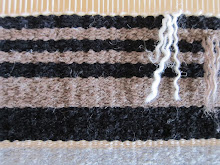I don’t think of myself as a consumer, but I love to shop
for some things. Groceries are top on my list. Did I write about this before?
How I came home late one evening from two years living in Guatemala and Mexico
and immediately went to the grocery store and walked up and down every aisle. I
just starred at all the boxes of cereal, all the types of cookies, all the
cheeses, and all the fruit and vegetables out of season for that area but
available to purchase anyway. These days I don’t go up and down every aisle, in
fact I never go past the boxed cereals or canned vegetables, but I still love
going to the supermarket and slowly going through my list. I try to limit
myself to a written list, but never manage to succeed. Besides the monthly
bills that must get paid (like the mortgage), the grocery stores get most of my
money. When times are rough, I ask Mark to do the shopping. He sticks to the
list.
The other item on which I spend money is books. I used to
buy textile related books. I have learned that if I see a book that looks good,
I had better get it, because it won’t be there next time I look. The bookstores
in Santa Fe always had something to tempt me. One memorable trip there, a
fantastic bookstore was going out of business, and we flew home with armfuls of
heavy art books. That was before the airlines started to charge for luggage.
The books stay with us, from house to house, as we crisscross the country. They
fill shelves in almost every room. Sometimes I don’t take one off the shelf for
months, but when I do, it is like visiting an old friend.

I go in cycles of topics. Indonesian textiles were high on
my list for a while. In fact, almost any book on ethnographic textiles will
catch my attention. These books are usually filled with lots of photos, and
admittedly, I have looked at the pictures more than I have read the texts. I
also like how-to books on weaving. No book has come close to Deborah Chandlers’
Beginning Weaving, one of the first
books I owned, but that doesn’t stop me from buying all the ones that have come
out since hers, explaining how to wind a warp, or set up a loom, or weave
simple fabrics. There is this thing that comes over me when I find one of these
books—I think it is called greed. I just have to have it. It’s as if my life
will not be complete unless that book is put on my shelf. This hasn’t happened
in Vermont because I have never seen a book on weaving that I don’t already own
in any of the bookstores here.

Lately cookbooks are calling to me. There used to be a
Borders within a half hour of my house, and I would loose myself looking at all
their cookbooks. Now I find I am creating quite a long wish list on Amazon;
books on chocolate are piling up fast. I haven’t actually made any chocolates
yet—but I am reading about them—and lusting after more books on them. Reading
is definitely less fattening than making and eating, but I know that soon I am
going to start…and then my list of needs will increase to molds, and dipping
forks, and exotic ingredients. Cookbooks always seem to lead to purchases of
kitchen tools.

Desire is an interesting phenomenon. I can thumb through
dozens of books and put them back on the shelf without a flicker of
interest—but suddenly, when something catches my fancy, it seems like dozens of
others are suddenly enticing. I have some control, so I whittle things down to
one or two purchases, which then trigger a delayed action. Sooner or later I
will be back to get the others. I have rationalized some of it. A book on
weaving or cooking is something you return to again and again. It isn’t an item
you can get from inter-library loan because you never are quite finished with
it. Even if it isn’t a very good cookbook or textile book, still you might need
to use it again in the future; and if it is a good cookbook or weaving book
then you definitely will need to use it again. These are research items. Research
is such a respectable word that allows me to indulge in consumerism. Mark
thinks I should do some weavings based on cooking. Now that will really
legitimize my research.




















